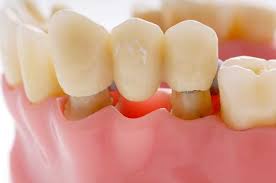You may have lost a tooth or two in the past as a result of an accident or something like that, and you’re looking to replace them with an artificial tooth or otherwise called a dental bridge, which, of course, is the only option. However, it is essential to know how much dental bridges cost. Depending on the type of dental bridge you need, the cost can run deep into the thousands; and with insurance, you can get up to half of your dental fees paid off. In this guide, we will be discussing how much dental bridges cost without insurance, but before that, let’s get to understand what a dental bridge is.
Understanding Dental Bridges
A dental bridge is essentially a bridge that spans a space in your mouth. A lost tooth is replaced with an artificial tooth that is glued to the natural teeth on either side of the gap. If you have had a tooth pulled or lost a tooth, a dental bridge may be required to replace the gap.
Dental bridges are classified into two categories. The most typical version consists of porcelain or metal crowns that are permanently attached to your natural teeth on either side of the space, with the fake tooth (or teeth) in the center. Your bridge dental work only replaces the crown. Some are single tooth bridges, while others can replace many teeth.
The cost of a dental bridge is determined by the type of bridge required. For example, if you have dental insurance, you may be able to get some of your costs covered. Before your operation, you will know what is covered by your dental insurance and how much your dental bridge will cost. Similarly, your dentist will let you know the cost and what’s not covered in your dental bridge without insurance.
Because your fixed bridge has a natural appearance, it is difficult to notice that part of your teeth is missing. If you take proper care of your permanent bridge, it should survive for roughly 15 years. Your dental bridge allows you to chew, speak and smile freely.
Benefits Of Dental Bridges
Dental bridges provide a long-term option for lost teeth. Bridges, unlike dental implants, can restore missing teeth without requiring surgery. With porcelain finishes, your new tooth may be virtually indistinguishable from the original teeth around it.
Furthermore, dental bridges can improve your confidence in your smile and simplify daily tasks like eating and talking. Replacing a lost tooth can also help safeguard the remaining teeth. For instance, when you have gaps in your teeth, your remaining teeth may lean over or migrate into the area, impacting how you bite. Food can also become stuck in crevices, increasing your chances of tooth decay. Dental bridges are an investment in your self-esteem, lifestyle, and oral health.
Types of Dental Bridges
The major determining factor of dental bridges’ cost with or without insurance is the type or kind of dental bridge you’re going for. Before we go into discussing how much dental bridges cost without insurance, let us quickly analyze the types of dental bridges there are.
#1. Porcelain
If you are going for this type of dental bridge, keep in mind that it will cost you more. Your bridge is made entirely of tooth-colored porcelain. This is the option that looks the most natural, but because of its fragility, it is only used for front teeth. Your porcelain dental bridge is made of metal and tooth-colored porcelain. Your back teeth are a good candidate for this since they provide more strength than all-porcelain bridges.
Despite the increased strength, your average cost is lower, but this bridge is just for your rear teeth because it does not seem natural. Your dental bridge can also be categorized based on how it fits in your mouth and how it is linked to the teeth around it. Depending on your particular situation, your dentist will advise you whether or not to go for this bridge type.
#2. Maryland
Without initially crowning your teeth, a Maryland bridge is fastened straight to your teeth on either side of the gap. Only one or two of your teeth can be replaced with this type of bridge. A Marland is frequently a single-tooth bridge. If the teeth next to your missing tooth cannot be prepared for a crown.
#3. Cantilever
Your dentist will be unable to attach your dental bridge on either side of the gap if you have lost one or more of your back teeth in a row. In this situation, he might suggest a cantilever bridge. This sort of bridge is just fastened to your crown on one side of your gap. If your dentist needs to crown a few of your teeth in front of the gap for extra support, the cost of your tooth bridge will rise significantly. Due to the significant strain on your teeth, you will need to have your dental bridge closely examined.
#4. Traditional Bridge
The average cost of a typical dental bridge is available because it is one of the most popular forms. Your teeth on either side of the gap are covered with dental crowns by your dentist. This kind of cap encloses each tooth completely. Then, your crowns are secured with your prosthetic tooth or teeth.
How Much Do Dental Bridges Cost Without Insurance
Your dental bridge cost is reasonable as a way to restore missing teeth. Your cost will vary, especially if you do not have dental insurance. The procedure can cost between $1,500 and $15,000, based on four factors—the type of bridge required, the number of missing teeth, the intricacy of the surgery, and your location. Let’s have a look at the type factor!
Traditional dental bridges require two anchor points, whereas cantilever bridges require only one, even when supporting several artificial teeth. Without insurance, the cost of a pontic with its abutment crown(s) ranges from $2,000 to $5,000.
Maryland dental bridges, on the other hand, have “wings” that are linked to the abutment teeth as well as the pontic itself. One pontic, with its abutment framework, costs between $1,500 and $2,500, making it considerably less expensive than a traditional bridge.
Lastly, two titanium dental implants covering three or four teeth cost between $5,000 and $15,000. Traditional, cantilever, and Maryland bridges can be installed in two sessions by a dentist, but implant-supported bridges may require three or more. Furthermore, you’ll need five to six months to heal from the surgical wounds before permanent teeth may be placed.
Your dentist may also prescribe pain medication following the operation. Monthly check-ups will extend the life of the dental bridge. The majority of this will be paid by insurance, so having it can be beneficial.
The number of missing teeth
The total cost of the treatment is greatly influenced by the number of pontics used. Similarly, if you have gaps between your teeth, you will need different bridges for each. This could increase the cost of the surgery.
The intricacy of the surgery
The method becomes more difficult as the gap becomes less accessible. The more difficult it is, the more expensive it will be. Furthermore, dental disorders such as periodontal disease can cause complications and must be treated before the treatment, incurring additional costs.
Location
If your state has higher healthcare costs, the cost of dental bridges without insurance may be generally affected. Healthcare expenses in several states have steadily risen over the last few years, with Houston’s being among them. This trend thereby emphasizes the importance of insurance coverage for dental bridges, which are not normally classified as a preventative procedure.
Treatment
You will most likely have concerns about the cost after your dentist tells you that a dental bridge is required. It is therefore recommended that you contact your insurance provider to find out how much a dental bridge costs with insurance. Remember that your dental bridge costs with insurance should be reduced. The procedure is easy and quick once you have authorized your dental bridge cost.
To finish your operation, you will require at least two appointments. The teeth on both sides of your gap are first prepared. If you require crowns, some of your enamel is removed to make room.
After that, an impression of your teeth is taken and sent to a lab. Your unique dental bridge is then made and delivered to your dentist in a matter of days. While you wait for your bridge, you will be given temporary crowns to protect your teeth from damage and irritation. A local anesthetic is used to relieve pain during your appointment.
Your temporary crowns will be removed and your dental bridge will be put into place during your second appointment. For a few weeks, your dentist may apply temporary cement to assess the feel and fit of your bridge. The fit will be discussed and any revisions made before permanently cementing your bridge during your third consultation.
What to Expect Afterwards
As expected, there may be minor gum discomfort or very slight sensitivity to hot and cold food and drink after the insertion of a dental bridge. Since the new tooth is covering the previous gap, it may also feel a little weird. But these problems ought to go away in a few days. When you bite together, new teeth can occasionally feel a little high. At subsequent visits, your dentist might make adjustments to fix little issues like these.
Bridges cannot be removed for cleaning because they are cemented in place forever. You must use specialized dental floss to clean the space beneath a bridge if you want to maintain the health of your natural teeth.
FAQs
Is bridge cheaper than an implant?
Compared to implants, dental bridges are typically less expensive up front, and insurance is more likely to at least partially cover the expense.
Can a bridge replace multiple teeth?
The restoration of two, three, four, or more teeth is what a dental bridge is typically used for. It can replace a single tooth as well. More crowns are required to support the bridge when there are more missing teeth, and the bridge is typically less stable.
Why is tooth bridge important
It restores your teeth’s ability to properly chew food and speak. It stops the movement of your remaining teeth, which can affect your bite. By lowering the chance of bone loss, it keeps your face’s facial structures intact. Since the bridges are permanently set in place, they cannot move like dentures.






